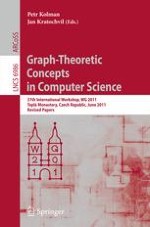2011 | Buch
Graph-Theoretic Concepts in Computer Science
37th International Workshop, WG 2011, Teplá Monastery, Czech Republic, June 21-24, 2011. Revised Papers
herausgegeben von: Petr Kolman, Jan Kratochvíl
Verlag: Springer Berlin Heidelberg
Buchreihe : Lecture Notes in Computer Science
